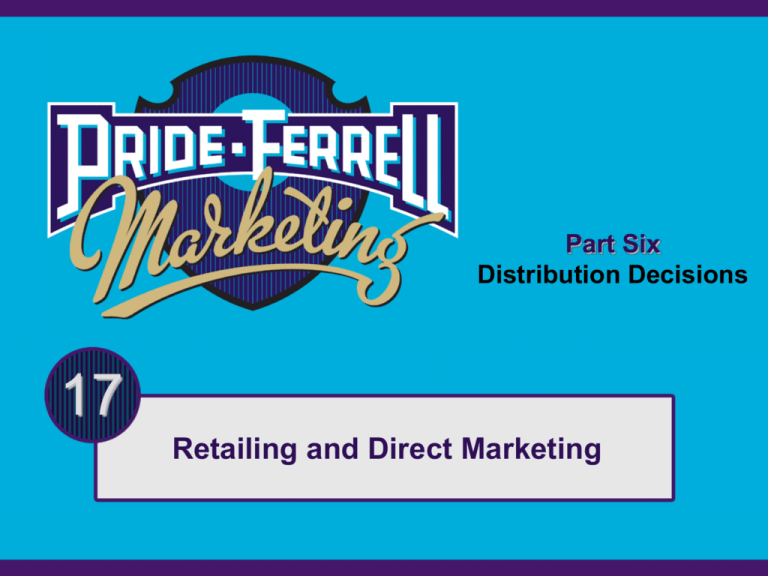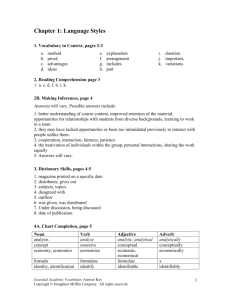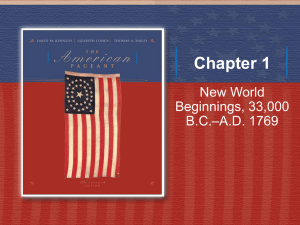
Part Six
Distribution Decisions
17
Retailing and Direct Marketing
Objectives
1. To understand the purpose and function of
retailers in the marketing channel
2. To identify the major types of retailers
3. To understand direct marketing and two
other forms of nonstore retailing
4. To examine major types of franchising and
the benefits and weaknesses of franchising
5. To explore strategic issues in retailing
Copyright © Houghton Mifflin Company. All rights reserved.
17 | 2
Chapter Outline
•
•
•
•
•
•
The Nature of Retailing
Major Types of Retail Stores
Direct Marketing
Other Types of Nonstore Retailing
Franchising
Strategic Issues in Retailing
Copyright © Houghton Mifflin Company. All rights reserved.
17 | 3
The Nature of Retailing
• Retailing
– Transactions in which ultimate consumers are the
buyers
• Retailers
– Organizations that purchase products for the
purpose of reselling them to ultimate consumers
• Retailers add value—shopping convenience, services,
and purchasing assistance to customers
• Retailers create utility—time, place, possession, and
form
– Success in retailing comes from having a strong
customer focus coupled with desired levels of
service, product quality, and innovation.
Copyright © Houghton Mifflin Company. All rights reserved.
17 | 4
Copyright © Houghton Mifflin Company. All rights reserved.
17 | 5
Major Types of Retail Stores
• General-Merchandise Retailers
– A retail establishment that offers a variety
of product lines
– Department stores
• Large retail organizations characterized by
wide product mixes and organized into
separate departments to facilitate marketing
efforts and internal management
– Discount stores
• Self-service, general merchandise stores
offering brand name and private brand
products at low prices
Copyright © Houghton Mifflin Company. All rights reserved.
17 | 6
Major Types of Retail Stores (cont’d)
• General-Merchandise Retailers (cont’d)
– Supermarkets
• Large, self-service stores
that carry a complete line
of food products, along
with some nonfood
products
– Superstores
• Giant retail outlets that carry food and nonfood
products found in supermarkets, as well as
most routinely purchased consumer products
Copyright © Houghton Mifflin Company. All rights reserved.
17 | 7
Major Types of Retail Stores (cont’d)
• General-Merchandise Retailers (cont’d)
– Hypermarkets
• Stores that combine supermarket and discount
shopping in one location
– Warehouse clubs
• Large-scale, members-only establishments
that combine features of cash-and-carry
wholesaling with discount retailing
Copyright © Houghton Mifflin Company. All rights reserved.
17 | 8
Major Types of Retail Stores (cont’d)
• General-Merchandise Retailers (cont’d)
– Warehouse showrooms
• Retail facilities in large, low-cost buildings with
large on-premise inventories and minimal
services
– Catalog showrooms
• A form of warehouse showroom where
consumers can shop from a catalog and
products are stored out of buyers’ reach
Copyright © Houghton Mifflin Company. All rights reserved.
17 | 9
Major Types of Retail Stores (cont’d)
• Specialty Retailers
– Traditional specialty retailers
• Also called “limited-line” and “single-line”
retailers
• Carry a narrow product mix with deep product
lines (e.g., pet supplies)
• Have higher costs and higher margins
• Provide more product selection (first-line
brands), product expertise, and high levels of
personal service
Copyright © Houghton Mifflin Company. All rights reserved.
17 | 10
Major Types of Retail Stores (cont’d)
• Specialty Retailers (cont’d)
– Off-price retailers
• Buy manufacturers’ seconds, overruns, returns, and offseason merchandise for resale to consumers at deep
discounts
• Charge less than department stores for comparable
merchandise and offer few customer services
• Have established long-term relationships with suppliers
for continuing supplies of reduced-price goods
– Category killers
• Concentrate on a major product category and compete
on the basis of low prices and product availability
Copyright © Houghton Mifflin Company. All rights reserved.
17 | 11
Direct Marketing
• Direct Marketing
– The use of telephone and nonpersonal
media to introduce products to consumers,
who then can purchase them via mail,
telephone, or the Internet
– A type of nonstore
retailing
• Nonstore Retailing
– The selling of products
outside the confines of
a retail facility
Copyright © Houghton Mifflin Company. All rights reserved.
17 | 12
Direct Marketing (cont’d)
• Catalog Marketing
– A type of marketing in which an
organization provides a catalog from which
customers can make selections and place
orders by mail, telephone, or the Internet
• Consumer advantages are efficiency and
convenience
• Marketer advantages are lower location,
facility, selling, and operating costs.
• Disadvantages are inflexibility and limited
selection and local service availability.
Copyright © Houghton Mifflin Company. All rights reserved.
17 | 13
Direct Marketing (cont’d)
• Direct-Response Marketing
– A type of marketing that occurs when a
retailer advertises a product and makes it
available through mail or telephone orders
• Telemarketing
– The performance of
marketing-related
activities by telephone
Copyright © Houghton Mifflin Company. All rights reserved.
17 | 14
Direct Marketing (cont’d)
• Television Home Shopping
– A form of selling in which products are
presented to television viewers, who can
buy them by calling a
toll-free number and paying
with a credit card
• Online Retailing
– Retailing that makes
products available to
buyers through computer
connections
Copyright © Houghton Mifflin Company. All rights reserved.
17 | 15
Other Types of Nonstore Retailing
• Direct Selling
– The marketing of products to ultimate consumers
through face-to-face sales presentations at home
or in the workplace
• Party plans: hosting groups to view a product
demonstration and encouraging participants to
purchase the products
– Benefits
• Personal attention to customer
• Convenience of time and place of presentation
– Limitations
• High costs make it the most expensive form of selling
• Negative consumer view of direct selling
Copyright © Houghton Mifflin Company. All rights reserved.
17 | 16
Other Types of Nonstore Retailing (cont’d)
• Automatic Vending
– The use of machines to dispense products
– Can include items such as candy, chewing
gum, soft drinks, cigarettes, newspapers,
and coffee
• Advantages: small amount of
space needed and no sales
personnel
• Disadvantages: high costs of
equipment and frequent servicing
Copyright © Houghton Mifflin Company. All rights reserved.
17 | 17
Franchising
• Franchising
– An arrangement in which a supplier
(franchiser) grants a dealer (franchisee)
the right to sell products in exchange for
some type of consideration
• Franchiser furnishes equipment,
buildings, management know-how,
and marketing assistance.
• Franchisee supplies labor and
capital and operates the business
by the provisions of the franchise
agreement.
Copyright © Houghton Mifflin Company. All rights reserved.
17 | 18
Copyright © Houghton Mifflin Company. All rights reserved.
17 | 19
Copyright © Houghton Mifflin Company. All rights reserved.
17 | 20
Major Types of Retail Franchises
• Manufacturer Authorization
– Product producer licenses retailers to sell its
brand name product(s)
• Distributor Authorization
– Product producer licenses distributors to sell its
brand name product to retailers
• Producer Authorization
– Franchiser supplies brand names, production
techniques, or other services to franchisee while
maintaining development and control of marketing
strategies
Copyright © Houghton Mifflin Company. All rights reserved.
17 | 21
Franchising (cont’d)
•Advantages
– Enables startup with
limited capital
– Provides developed
and proven business
to franchisee
– Attracts customers
with established brand
name
– Allows immediate
market entry
– Motivates franchisee
to succeed
Copyright © Houghton Mifflin Company. All rights reserved.
•Disadvantages
– Control over aspects
of the business and its
operations by
franchiser
– Expense of continuing
franchise royalties
and advertising fees
– Lack of control of
franchisees by
franchisor
17 | 22
Strategic Issues in Retailing
• Retail Store Location
– Factors affecting location
• Intended target market
• Kinds of products
• Suitability site for customer
access
• Characteristics of existing
retail operations
• Types of Locations
– Free-standing structures
– Traditional business districts
Copyright © Houghton Mifflin Company. All rights reserved.
17 | 23
Strategic Issues in Retailing (cont’d)
• Traditional Shopping Centers
– Neighborhood shopping centers
• Usually consist of several small convenience
and specialty stores.
– Community shopping centers
• Include one or more department stores
(anchors), some specialty stores, and
convenience stores.
– Regional shopping centers
• Have the largest department stores, the widest
product mix, and the deepest product lines of
all shopping centers.
Copyright © Houghton Mifflin Company. All rights reserved.
17 | 24
Strategic Issues in Retailing (cont’d)
• Nontraditional Shopping Centers
– Factory outlet malls
• Feature discount and factory outlet stores
carrying traditional brand name products
– Miniwarehouse mall
• Loosely planned; lease space to retailers
running retail stores out of warehouse bays
– Nonanchored malls
• Do not have traditional department store
anchors; combine off-price and category killer
stores in a “power center” format
Copyright © Houghton Mifflin Company. All rights reserved.
17 | 25
Strategic Issues in Retailing (cont’d)
• Retail Positioning
– Identifying an unserved or underserved market
segment and serving it through a strategy that
distinguishes the retailer from others in the minds
of consumers in that segment
• Store Image
– Atmospherics
• The physical elements in a store’s design that appeal to
consumers’ emotions and encourage buying
• Interior layout, colors, furnishings, and lighting
• Exterior storefront and entrance design, display
windows, and traffic congestion
Copyright © Houghton Mifflin Company. All rights reserved.
17 | 26
Strategic Issues in Retailing (cont’d)
• Scrambled Merchandising
– The addition of unrelated products and product
lines to an existing product mix, particularly fastmoving items that can be sold in volume
– Intent of scrambled
merchandising
• Convert stores into one-stop
shopping centers
• Generate more customer traffic
• Realize higher profit margins
• Increase impulse purchases
Copyright © Houghton Mifflin Company. All rights reserved.
17 | 27
Strategic Issues in Retailing (cont’d)
• The Wheel of Retailing
– A hypothesis holding that new retailers
usually enter the market as low-status,
low-margin, low-price operators but
eventually evolve into high-cost, high price
merchants.
Copyright © Houghton Mifflin Company. All rights reserved.
17 | 28
The Wheel of Retailing
Source: Adapted from Robert F. Hartley, Retailing: Challenge and Opportunity, 3rd ed., p. 42. Copyright © 1984
by Houghton Mifflin Company. Used by permission.
Copyright © Houghton Mifflin Company. All rights reserved.
FIGURE 17.1
17 | 29
After reviewing this chapter you should:
• Understand the purpose and function of
retailers in the marketing channel.
• Be able to identify the major types of retailers.
• Recognize the various forms of nonstore
retailing.
• Have examined the major types of franchising
and the strengths and weaknesses of
franchising.
• Have explored strategic issues in retailing.
Copyright © Houghton Mifflin Company. All rights reserved.
17 | 30


